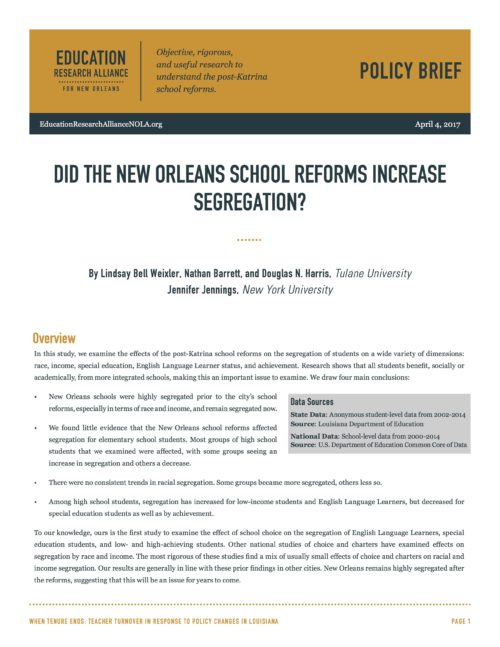New Report Released: "Did the New Orleans School Reforms Increase Segregation?"
A new study from the Education Research Alliance for New Orleans at Tulane University examines how the post-Katrina school reforms affected segregation in New Orleans publicly funded schools.
Researchers analyzed changes in segregation across a number of student demographics, including race, income, special education participation, English Language Learner status, and achievement.
New Orleans schools were highly segregated prior to the reforms, especially in terms of race and income, and the study finds that segregation levels remain high post-Katrina. The authors find little evidence that the reforms affected segregation for elementary school students, but most groups of high school students they examined were affected.
The authors, Lindsay Bell Weixler, Nathan Barrett, Douglas Harris, and Jennifer Jennings, also find no consistent trends in racial segregation, as some student groups became more segregated and others less so. Among high school students, segregation has increased for low-income students and English language learners but decreased for special education students. The study also finds that segregation by achievement levels has generally declined since Katrina.
“Integrating schools has been a long-standing challenge for districts,” Weixler said. “Our results for New Orleans confirm the broader national pattern that very few school systems—whether traditional or those with choice-based reforms—have had much success in integrating schools.”

In this study, we examine the effects of the post-Katrina school reforms on the segregation of students on a wide variety of dimensions: race, income, special education, English Language Learner status, and achievement. Research shows that all students benefit, socially or academically, from more integrated schools, making this an important issue to examine. We draw four main conclusions:
- New Orleans schools were highly segregated prior to the city’s school reforms, especially in terms of race and income, and remain segregated now.
- We found little evidence that the New Orleans school reforms affected segregation for elementary school students. Most groups of high school students that we examined were affected, with some groups seeing an increase in segregation and others a decrease.
- There were no consistent trends in racial segregation. Some groups became more segregated, others less so.
- Among high school students, segregation has increased for low-income students and English Language Learners, but decreased for special education students as well as by achievement.
To our knowledge, ours is the first study to examine the effect of school choice on the segregation of English Language Learners, special education students, and low- and high-achieving students. Other national studies of choice and charters have examined effects on segregation by race and income. The most rigorous of these studies find a mix of usually small effects of choice and charters on racial and income segregation. Our results are generally in line with these prior findings in other cities. New Orleans remains highly segregated after the reforms, suggesting that this will be an issue for years to come.
This spring, the Education Research Alliance for New Orleans is also releasing a series of papers that focus on New Orleans teachers. The first study in this series, which explored the effects of Louisiana’s teacher tenure reform, was released in February. Forthcoming studies will examine the implementation of the statewide teacher evaluation system known as Compass, as well as changes in teachers’ perceptions of New Orleans schools from those who taught before and after Hurricane Katrina.New Report Released: "Did the New Orleans School Reforms Increase Segregation?" · News · Education Research Alliance for New Orleans:



